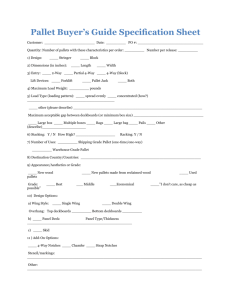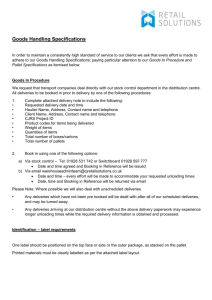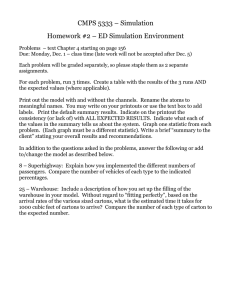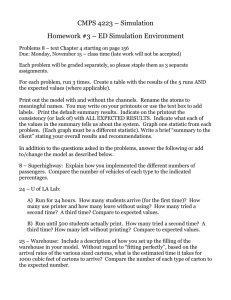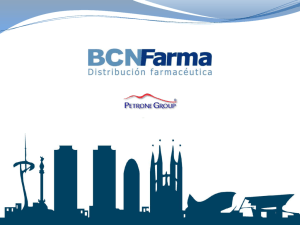Sneaky Sneakers
advertisement
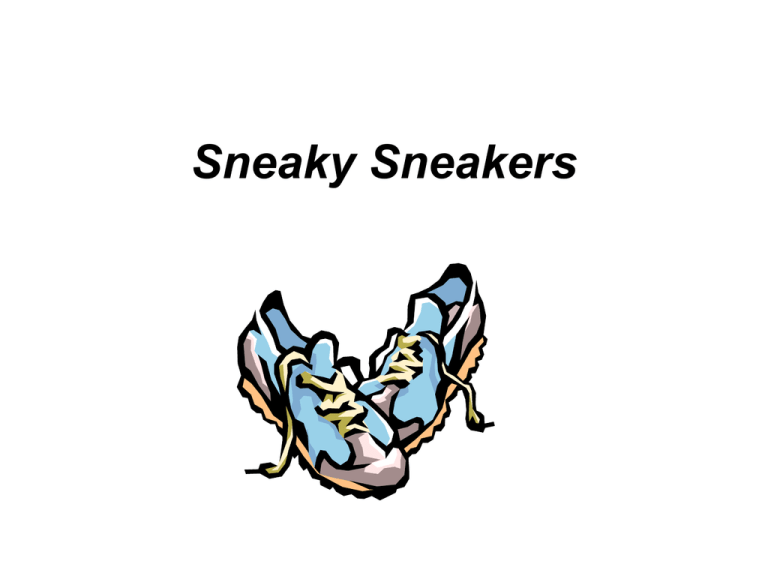
Sneaky Sneakers Existing Conditions Company Profile Sneaky Sneakers (SS) is a retailer that sells athletic shoes in it own stores. It currently operates 500 stores that are located primarily in shopping malls. They have recently opened their website and are now selling shoes directly to consumers. They have outgrown their current facilities, and they need to design a new distribution center that will be able to handle their retail and internet business in the same facility. Facility Description Sneaky Sneakers has found a property for their new distribution center. This 200,000 square foot existing facility features 32’-0” available clear stacking height to the top of the top load (including clearances required for overhead sprinklers). SS would have to sign a 5 year lease on the facility. The facility lease cost is $4/square foot/year. The landlord will allow SS to lease the space they will require for their operation. Any unused space by SS may be leased to another party and will not be available to SS after that. Empty Facility Space QuickTime™ and a TIFF (Uncompressed) decompressor are needed to see this picture. Typical Bay is 55’-0” x 44’-6” Operational Details Sneaky Sneakers has a warehouse where they house their current operations. This warehouse is approximately 75,000 square feet. Cases are received floor-stacked in containers from overseas. Pallets are built manually on the receiving dock and then moved to storage. All product is stored in pallet lanes. Not all pallets are stored in this facility. SS uses another remote warehouse to store overflow pallets. Pallets from the overflow warehouse arrive already palletized. Cases are picked from pallets on the floor to complete orders. Manual pallet jacks are used to travel the warehouse and build orders. Completed pallets are moved to the shipping dock where they are stretchwrapped and paperwork is generated. Pallets are then shipped via LTL carriers to the retail stores. Future Conditions Future Conditions The current operation supports 500 retail stores. A store normally receives a replenishment order every 2 weeks. A normal replenishment order is 5 pallets and consists of mixed SKUs on all pallets. SS plans on adding an additional 75 stores per year for the next few years. SS’s new internet-catalog business is just taking off as well. They currently offer 100 SKUs to their online customers. The are fulfilling 250 orders/day out of their online business. They hope to grow this area of their business at 20% per year and expand their online catalog to include all of their SKUs (approximately 2000). Returns SS Management anticipates Returns becoming a significant operation with the expansion of their internet-catalog business. It is anticipated that anywhere from 3% to 15% of all orders will be returned. SS needs to have a work area designed that will allow for the quick and efficient processing of a returned merchandise, and with flexibility to handle the high or the low end of the returns rate. Product Information – Cartons range in size from 16”x12”x8” (48 cartons/pallet) to 28”x18”x12” (16 cartons per pallet) – Pallets hold approximately 50 cubic feet of product – Current operations have been found to have insufficient receiving and shipping staging. On peak days, pallets from both docks clog up the aisles in the storage/picking area. – Damage of cartons is currently a major problem. – All product is received in cartons. The retail replenishment business does not require the breaking of the full cases. The new internet business has required that pickers open a case up to remove one pair of shoes to fill an order. Operational Details • A one shift operation is now in place. SS hope to maintain this in the future. • Receiving occurs between 8:00am and 11:30 am. • Large inventory items are stored in bulk floor lanes (average 2.5 pallets high). • Most SKUs have picking locations on the floor that can be accessed by pickers. Some SKUs require pallet juggling to complete orders. • Carriers arrive between 2pm and 4:30pm daily. On an average day, approximately 1/2 of the staged product is shipped. The average stay for a case on the shipping dock is 1.8 days. Operational Data Operational Data There has been some limited analysis of the current state of Sneaky Sneaker’s operation. The following data reports have been made available for your use: • • • • Receiving Log - Last 3 weeks Inventory Profile - Peak inventory level Shipping Profile - Peak shipping month Order Characteristics – Lines/Order & Cartons/Order Receiving Log Receiving Data Date 2/28/00 2/29/00 3/1/00 3/2/00 3/3/00 3/6/00 3/7/00 3/8/00 3/9/00 3/10/00 3/13/00 3/14/00 3/15/00 3/16/00 3/17/00 Total Average Max # of Trucks # of Pallets 8 7 7 5 6 11 8 9 6 5 9 7 8 7 4 256 224 224 160 192 352 256 288 192 160 288 224 256 224 128 107 7 11 3,424 228 352 Inventory Data Inventory Analysis Range (Pallets) 0 - 0.25 0.25 - 1 1-4 5 - 10 11 - 20 21 - 40 41 - 100 > 100 Totals Peak Inventory # of % of Total SKUs SKUs Pallets 450 23.2% 710 36.5% 533 368 18.9% 1,104 177 9.1% 1,416 111 5.7% 1,776 66 3.4% 2,046 41 2.1% 3,075 20 1.0% 2,600 1,943 100.0% 12,550 % of Pallets 0.0% 4.2% 8.8% 11.3% 14.2% 16.3% 24.5% 20.7% 100.0% Shipping Data Volume Analysis Peak Month Volume in Pallets Range (Pallets) 0 0 - 0.25 0.25 - 0.50 0.50 - 1 1-2 2-5 5 - 10 10 - 50 50 + Totals: # of SKUs 88 394 741 344 214 122 67 19 11 2,000 % of SKUs Total Pallets 4.4% 19.7% 79 37.1% 297 17.2% 276 10.7% 386 6.1% 488 3.4% 590 1.0% 872 0.6% 1,419 100.0% 4,407 % of Pallets 0.0% 1.8% 6.7% 6.3% 8.8% 11.1% 13.4% 19.8% 32.2% 100.0% Order Characteristics Lines per Order 1 2 6-10 10-20 20+ Totals: Cartons per Order 1 2-20 20-50 50-160 160-300 300+ Totals: Stores Total Orders 1 2 7 21 19 50 % Of Orders Stores 2.0% 4.0% 14.0% 42.0% 38.0% 100.0% Stores Total Orders 1 3 6 20 16 4 50 % Of Cartons Stores 2.0% 6.0% 12.0% 40.0% 32.0% 8.0% 100.0% 1 4 60 357 665 1,087 InternetTotal Orders 222 19 8 1 250 % Of Orders Internet 88.8% 7.6% 3.2% 0.4% 0.0% 100.0% Total Cartons Stores 1 30 240 2,000 2,720 1,300 6,291 InternetTotal Orders 211 37 2 250 % Of Cartons Internet 84.4% 14.8% 0.8% 0.0% 0.0% 0.0% 100.0% Total Lines - Stores Total Lines Combined - Internet Orders 222 38 68 12 340 Total Cartons Internet 211 111 44 366 223 21 15 22 19 300 Combined Orders Typical Daily Order Profile 212 40 8 20 16 4 300 % of Total Orders 74.3% 7.0% 5.0% 7.3% 6.3% 100.0% % of Total Orders 70.7% 13.3% 2.7% 6.7% 5.3% 1.3% 100.0% Combined Lines 223 42 128 369 665 1,427 Combined Cartons 212 141 284 2,000 2,720 1,300 6,657 % of Total Lines 15.6% 2.9% 8.9% 25.9% 46.6% 100.0% % of Total Cartons 3.2% 2.1% 4.3% 30.0% 40.9% 19.5% 100.0% Order Characteristics Order Statistics Average Lines/ Order Average Cartons/Order Average Cartons/Line Retail Stores 21.7 125.8 5.8 Internet/ Catalog 1.4 1.5 1.1 Combined Typical Daily Order Statistics 4.8 22.2 4.7 Project Statement & Deliverables Project Statement Your team will design a new distribution center using good material handling practices. The project will require analysis and design of material flow, selection of appropriate material handling equipment, and a detailed description of the operation. The submitted designs will be judged in a competition. Project Deliverables • A report (30 pages max) which must include: – A written description of the operation and the decisions that were made during design. – A list of the equipment used in the operation. • A 3.5”diskette (labeled with team members names and school) that includes: – A layout of the final design submitted as an AutoCAD (.dwg) or Adobe (.pdf) file. • A professional engineering presentation that: – describes the major findings, and – explains the functionality of the proposed design. Project Evaluation – – – – – Projects will be evaluated using the following criteria: Product Flow – A winning design will propose a layout that allows for the most effective operation, while minimizing the travel distances of product and people. Equipment Utilization – A winning design will describe and cost justify the choices and rationale used in the selection of types and quantities of equipment. Space Utilization – The winning design will illustrate the best use of cubic capacity of the building without sacrificing the operational effectiveness. Operational Plan – The winning design will have an accompanying operational plan that clearly describes overall system features and operational details. This includes the job requirements, use of all equipment, integration of any computer/WMS technology, and guidelines for running this operation efficiently and safely for employees. Overall Integration - The winning design will clearly illustrate overall integration of the previous four categories. Equipment • You can use any material handling/storage equipment including but not limited to: – – – – – – – – – Pallet Rack - Single or Double Deep Pushback Rack, Drive-in Rack Lift Truck - Counterbalanced,Reach, Turret, Jacks Case Flow Rack, Shelving, Carousels Pallet Flow Systems Dock levelers, Dock equipment Conveyor - Powered and Gravity Computers - WMS, scanners, RF technology Mezzanines QuickTime™ and a TIFF (Uncompressed) decompressor are needed to see this picture. QuickTime™ and a TIFF (Uncompressed) decompressor are needed to see this picture. QuickTime™ and a TIFF (Uncompressed) decompressor are needed to see this picture.

